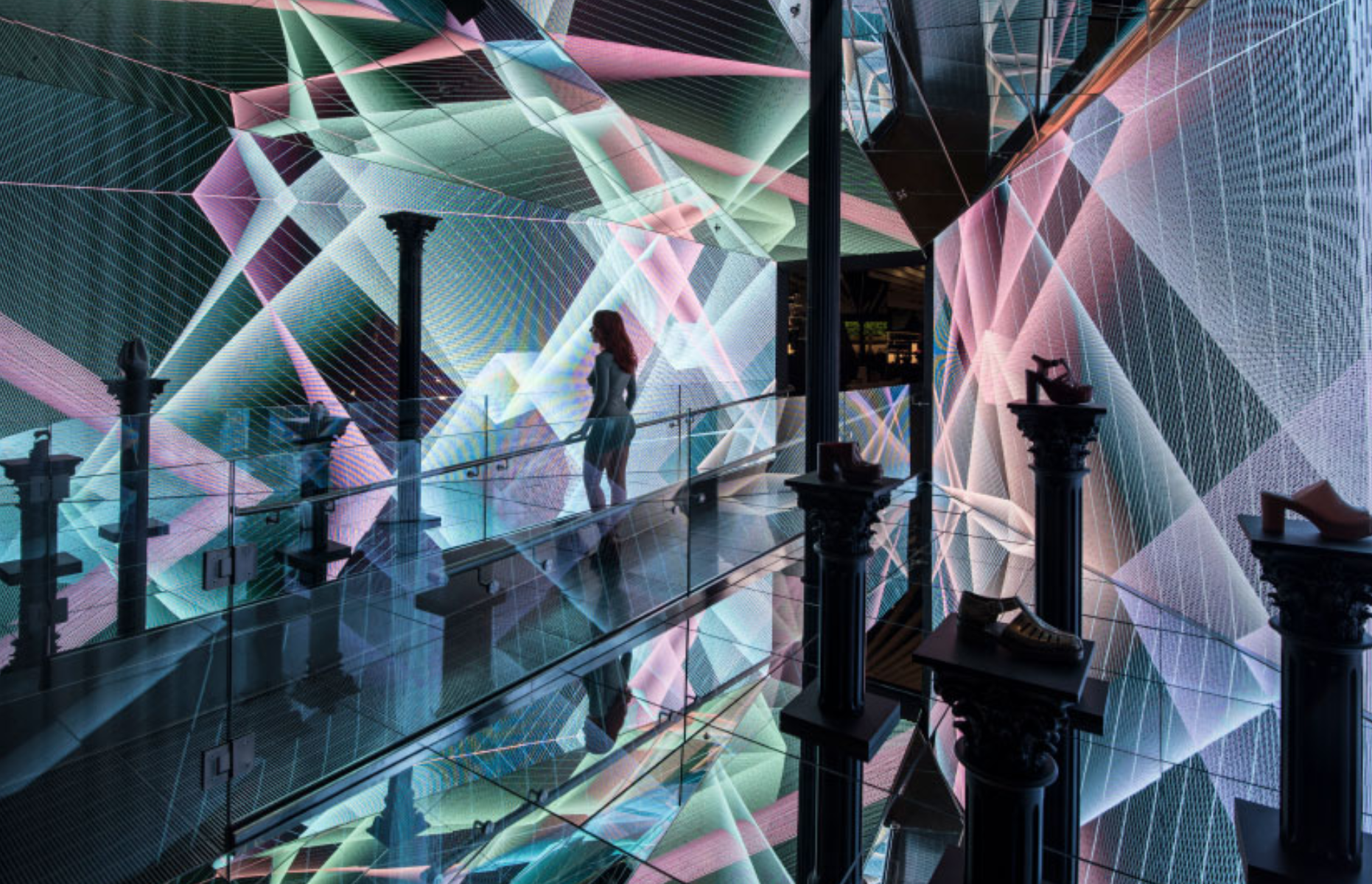Audrey Wachs reports on the opening of Galeria Melissa, an upscale boutique in New York City designed by Muti Randolph and featuring a video installation by Signe Pierce, for Architects Newspaper.
Plastic shoes and feminist art make a standout pair at Galeria Melissa NYC
By Audrey Wachs
It takes a lot to get a walking New Yorker to look up. Entranced by a phone, or scanning the sidewalk for the fastest way forward, only an explosion, a gunshot, or a really cute puppy can grab one’s attention. So it was with surprise that this writer witnessed, on a recent summer morning, a gaggle of people surrounding a new shoe store on Broadway, in Soho.
That store is Galeria Melissa NYC, and the people were staring at feminist video art on two really large screens. Inside, the boutique, by Brazilian designer Muti Randolph, is a footwear paradise in a gallery.
This is not the first New York store for Melissa, nor is it the first time the brand, also from Brazil, has worked with the designer. Though Randolph’s vision guided the design of this space, Melissa’s parent company, Grendene, enlisted a local firm to make it all happen.
Grendene chose Mancini Duffy for its deep roots in the city and for its retail expertise. Perhaps best known for corporate interiors for clients NBC Sports Group and A+E Networks, the firm has also redesigned one floor of Saks Fifth Avenue, and remade multiple Bloomingdales. So what’s the difference between designing for a department store versus street-level retail?
Here, Mancini Duffy did almost nothing to alter the landmarked cast-iron facade, and the store is impossible to miss from the street. In the triangular vestibule, two giant LED screens reflect infinitely off of mirrored flooring. On a recent visit, the screens displayed work by artist Sam Cannon as part of The Future of Her, an in-house exhibition curated by sisters Kelsey & Rémy Bennett. Cannon’s video, a pastiche of mildly subversive candy-colored women’s bodies coated in fluid, heralds the shiny smooth plastic shoes on the main sales floor, just up a metal-lined ramp.
The aesthetic is futuristic, if your vision of the future includes lots of lasers. Plastic shoes shine like wet Barbie feet, and the merch looks even more vibrant thanks to white LED ceiling lights. The ribboned overhead lighting is rigged to an MDS lacquered box, which beams out light across at least three walls of mirrors (four if you count the shoes displayed, Hall of Minerals–style, behind a two-way mirror).The Guardian mirror floor and ceiling give the impression of a never-ending space. (Alex Fradkin)
Melissa’s second life on social media, particularly on Instagram, played no small role in the store’s design. Thanks to online shopping, “there’s been a paradigm shift in how retail works,” said Ali Aslam, designer at Mancini Duffy. Though some decry the death of brick-and-mortar retail, the proliferation of images on the internet is transforming real-life stores into “boots-on-the-ground marketing for brands.”
To do this effectively, the team employed eye-catching everything to make the space stand out in that sea of hashtags. In a nod to the structural cast iron columns that dot the main floor, shoes are set out on mini millwork-and-plaster columns, painted a shiny black. While the smaller, movable white displays are lacquer-painted medium-density fiberboard (MDF), the larger, central ones arranged around the structural columns are fabricated in Corian.
Though it’s tempting to linger in the main area Instagramming, there are two more rooms to explore. Near the cashier’s desk, a lush green wall beckons from the rear of the space. The architects worked with plantwalldesign, which also did the green wall at Lincoln Center, for this project; the plants can live for decades under (carefully calibrated) light and irrigation systems.
The cashier’s desk, Aslam said, exemplifies the collaboration between Randolph and Mancini Duffy. The artist rendered a piece with a long cantilevered edge that looked cool, but would be almost impossible to build. The architects worked with him from the ground up, using the firm’s in-house design lab to 3-D print a model. That model was sent to a millworker in Brazil to create a desk that was “almost to a T the exact thing we agreed on,” Aslam said.
Another mini-room, kitty-corner from the cashier’s desk, contains shoes, but the main focus is an immersive video artwork by Signe Pierce, a self-described “reality artist.”
The store will host four exhibits annually, a figure that handily coincides with the four best shoe-buying seasons (all of them).


